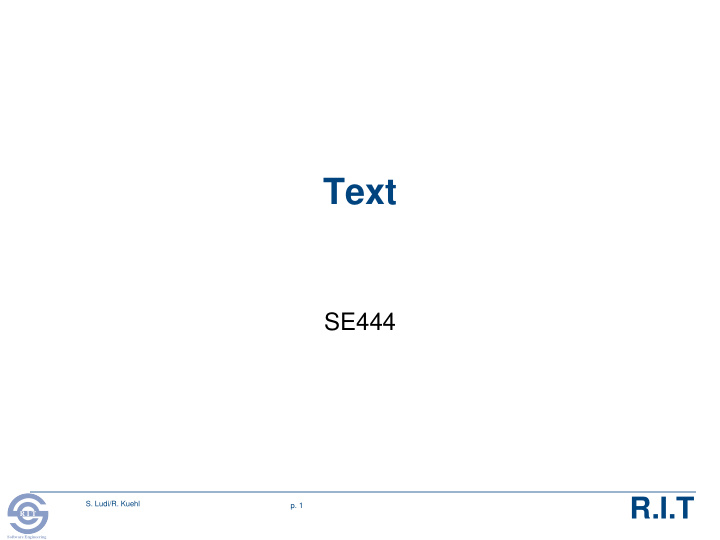



Text SE444 R.I.T S. Ludi/R. Kuehl p. 1 R I T Software Engineering
Text Topics Human reading process Using Text in Interaction Design R.I.T S. Ludi/R. Kuehl p. 2 R I T Software Engineering
Humans and Text – the Reading Process Saccades – quick, jerky eye movements forward 8-10 letters at a time plus CR/LF to the next line Fixation – pauses on areas of interest for understanding Regression – backward saccade due to comprehension, legibility, readability Experienced readers recognize word shapes First distinguish letters or words, then associate meaning • Gutenberg rule – reading gravity pulls the eyes from the top left to the bottom right R.I.T S. Ludi/R. Kuehl p. 3 R I T Software Engineering
Humans and Text – the Reading Process (cont) Upper case to identify single words, lower case is better for continuous reading We read extended text passages more quickly in lowercase/mixed case than uppercase Lowercase words have more distinctive shapes Uppercase words have more uniform shapes R.I.T S. Ludi/R. Kuehl p. 4 R I T Software Engineering
Analog (Paper) versus Digital (Screens) What is the purpose of reading – continuous (novel) or disjointed scanning? Advantages of digital? Storage, searching, bookmarking, hyperlinks, transmission, multi reader platforms, sharing Advantages of paper? No electricity required More portable in a wide set of conditions Spatial cues (page and book site) aid searching Physical manipulation Annotation, highlighting? Security R.I.T S. Ludi/R. Kuehl p. 5 R I T Software Engineering
Using Text in Interface Design Commentary text – information about the system or system functionality; Microsoft categories Contextual help - immediate assistance without requiring leaving the context of work, such as pop-up menus. Procedural help - steps necessary for carrying out a task. Reference help - an online reference book. Conceptual help - background information, feature overviews, or processes. Instrumental text – information directly related to user functionality Controls – buttons, checkboxes, icons, menus, etc. Hyperlinks R.I.T S. Ludi/R. Kuehl p. 6 R I T Software Engineering
Design Issues in Using Text Legibility – essential to be able to distinguish characters and words Display environment especially ambient light User age and/or vision disabilities Font size , foreground/background contrast Readability – comprehension of the text User’s language – avoid jargon, technical language, popular buzz words, specialized metaphors; e.g., “zip a file” Ambiguity – misunderstood or unclear meaning of words “Exit” “Quit” “Close” “Hibernate” vs “sleep” R.I.T S. Ludi/R. Kuehl p. 7 R I T Software Engineering
Physical Factors in Text Design Reading performance and comprehension affected by the interaction of ….. Font size Line length Margin width Vertical line spacing Alignment Contrast Scrolling versus paging Highlighting R.I.T S. Ludi/R. Kuehl p. 8 R I T Software Engineering
Physical Factors in Text Design Factors that affect font size : Reading Distance — Greater distances -> larger text. Screen Resolution — Smaller text requires greater resolution to keep the characters clear and legible. Text/Background Contrast — Negative contrast is optimal (black type on a white background). Visual Acuity of User Type of Reading — Text can be scanned, read word by word, or read character by character General benchmark formula for font size, given normal vision and optimal conditions: Font Size = 2 d (tan( /2)) X DPI d= distance, = viewing angle R.I.T S. Ludi/R. Kuehl p. 9 R I T Software Engineering
Physical Factors in Text Design (cont) Line length – no difference for comprehension but a factor for speed and accuracy Balance reader preference and optimal reading speed; 50 – 100 characters per line Shorter lines, larger margins Double spacing (but then smaller font size) Margin width Shorter lines — 4 inches — with large margins increased reading performance Maximal use of white space Alignment – left, right, centered, justified Avoid right and centered for best reading performance Text is another graphical page element for page layout R.I.T S. Ludi/R. Kuehl p. 10 R I T Software Engineering
Physical Factors in Text Design (cont) Contrast – between text and its background In general, best readability is background brighter than text Most readable black and white – black text on white background Most readable color – ?? green text on white background Green text on white background R.I.T S. Ludi/R. Kuehl p. 11 R I T Software Engineering
Physical Factors in Text Design (cont) Paging versus scrolling Paging generally preferred but research is mixed Best choice depends on the task, layout, and UI technology Selected guidelines: Eliminate horizontal scrolling Scrolling better for reading comprehension Facilitate rapid scrolling while reading Provide page navigation hyperlinks (previous, next) Text highlighting – bold, italics, underlining, color, etc. for emphasis R.I.T S. Ludi/R. Kuehl p. 12 R I T Software Engineering
Digital Text Representation Character – the representation of a letter, number, or other symbol Glyph – the physical representation of a character (or combinations) as a graphical pattern – A Character repertoire – all the glyphs required to create the characters for a language Character set – digital encoding scheme such as ASCII or Unicode for a character repertoire Fonts – a specific design for the glyphs in a character repertoire Typeface – family of fonts based on the same glyphs but with different design features (e.g., width) R.I.T S. Ludi/R. Kuehl p. 13 R I T Software Engineering
Fonts Serif Sans-Serif Cursive Variable-width font ioioioioio ioioioioio Fixed-width font R.I.T S. Ludi/R. Kuehl p. 14 14 R I T Software Engineering
Text Don’t use more than 2 or 3 typefaces, 4 -5 fonts Dimensions of a font R.I.T S. Ludi/R. Kuehl p. 15 R I T Software Engineering
Why Fonts Matter! R.I.T S. Ludi/R. Kuehl p. 16 R I T Software Engineering
Recommend
More recommend